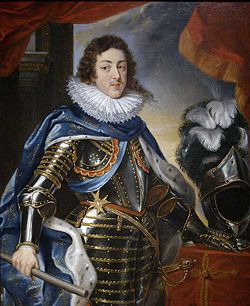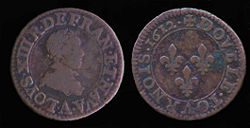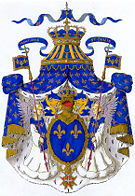Louis XIII of France
- For the cognac, see Louis XIII de Rémy Martin.
| Louis XIII | |
|---|---|
| King of France and Navarre (more...) | |
 |
|
| Louis XIII, by Philippe de Champaigne | |
| Reign | 14 May 1610 – 14 May 1643 |
| Coronation | 17 October 1610 |
| Predecessor | Henry IV |
| Successor | Louis XIV |
| Consort | Anne of Austria |
| Issue | |
| Louis XIV Philip, Duke of Orléans |
|
| Royal house | House of Bourbon |
| Father | Henry IV |
| Mother | Marie de' Medici |
| Born | 27 September 1601 Château de Fontainebleau, France |
| Died | 14 May 1643 (aged 41) Paris, France |
| Burial | Saint Denis Basilica, France |
Louis XIII (27 September 1601 – 14 May 1643) ruled as King of France and Navarre from 1610 to 1643.
Contents |
Early life
Born at the Château de Fontainebleau, Louis XIII was the youngest child of Henry IV of France (1589–1610) and Marie de' Medici. As the eldest son of the king, he was a Fils de France. His father was the first Bourbon King of France, having succeeded his ninth cousin, Henry III of France (1574–89), in application of Salic law. Louis XIII's paternal grandparents were Antoine de Bourbon, Duke of Vendome and Jeanne d'Albret, Queen of Navarre; his maternal grandparents were Francesco I de' Medici, Grand Duke of Tuscany and Johanna, archduchess of Austria, and Eleonora de' Medici, his maternal aunt, was his godmother[1]
|
||||||||||||
Louis XIII ascended to the throne in 1610, at the age of eight and a half, upon the assassination of his father. His mother acted as Regent until Louis XIII came of age at thirteen, but she clung to power unofficially until he took the reins of government in frustration at the age of fifteen. The assassination of Concino Concini (24 April 1617), who had greatly influenced Marie's policymaking, and Marie's exile to Blois, removed her from power. Louis then came into his own as ruler of France. He filled his court with loyal friends and sidelined those who remained loyal to his mother. Under Louis XIII's rule, the Bourbon Dynasty sustained itself effectively on the throne that Henry IV had recently secured; but the question of freedom of religion continued to haunt the country.
Cardinal Richelieu played a major role in Louis XIII's administration from 1624, decisively shaping the destiny of France for the next 29 years. As a result of Richelieu's work, Louis XIII became one of the first examples of an absolute monarch. Under Louis XIII the Habsburgs were humiliated, the French nobility was firmly kept in line behind their King, and the political and military privileges granted to the Huguenots by his father were retracted (while their religious freedoms were maintained). Furthermore, Louis XIII had the port of Le Havre modernized and built a powerful navy. Unfortunately time and circumstances never permitted King and Cardinal to attend to the administrative reforms (particularly of France's tax system) which were urgently needed.
| Coin of Louis XIII, struck 1612 | |
|---|---|
 |
|
| Obverse: (Latin) LUVS XIII, R[EX} DE FRAN[CORUM] ET NAVA[RRE], or in English, "Louis XIII, King of France and Navarre." | Reverse: (Latin) DOVBLE TOVRNOIS, 1612, or in English, "Double Tournois, 1612." |
The King also worked to reverse the trend of promising French artists leaving for Italy to work and study. Louis XIII commissioned the artists Nicolas Poussin and Philippe de Champaigne to decorate the Louvre. In foreign matters, Louis XIII organized the development and administration of New France, expanding the settlement of New France westward along the Saint Lawrence River from Quebec City to Montreal.
Personal relationships
On 9 November, 1615, aged only 14, Louis XIII was married to a Habsburg Princess, Anne of Austria (1601–66), daughter of King Philip III of Spain (1578–1621). This marriage followed a tradition of cementing military and political alliances between the Catholic powers of France and Spain with royal marriages. The tradition went back to the marriage of King Philip II of Spain with the French princess, Élisabeth de Valois, the daughter of King Henry II of France, in 1559 as part of the Peace of Cateau-Cambrésis. The marriage, like many Bourbon-Habsburg relationships, was only briefly happy, and the King's duties often kept them apart. After 23 years of marriage and four miscarriages, Anne finally gave birth to a son in 1638.
There is no evidence whether Louis had mistresses (consequently earning the title of 'Louis the Chaste'), but persistent rumours insinuated that the King may have been homosexual or at least bisexual. Tallemant des Réaux, in his Historiettes, explicitly speculated what happened in the king's bed.[2] A liaison with an equerry, Francois de Baradas, ended when the latter lost favour fighting a duel after duelling had been forbidden by royal decree.[3] He was also allegedly captivated by Marquis de Cinq-Mars; who was later executed for conspiring with the Spanish enemy in time of war. Tallemant described how on a royal journey, the king "sent M. le Grand to undress, who returned, adorned like a bride. 'To bed, to bed' he said to him impatiently... and the mignon was not in before the king was already kissing his hands."[4]
| House of Bourbon |
 |
|---|
| Henri IV |
| Sister |
| Catherine, Duchess of Lorraine |
| Children included |
| Louis XIII |
| Elisabeth, Queen of Spain |
| Christine Marie, Duchess of Savoy |
| Nicholas Henri, duc d'Orléans |
| Gaston, duc d'Orléans |
|
Henriette-Marie, Queen of England |
| Louis XIII |
| Children |
| Louis XIV |
| Philippe, duc d'Orléans |
| Louis XIV |
| Children included |
| Louis, Dauphin |
| Marie-Anne |
| Marie-Therèse |
| Philippe-Charles, duc d'Anjou |
| Grandchildren included |
| Louis, Dauphin |
| King Felipe V of Spain |
| Charles, duc de Berry |
| Great Grandchildren included |
| Louis, Dauphin |
| Louis XV |
| Louis XV |
| Children included |
| Louise-Elisabeth, duchesse de Parme |
| Madame Henriette |
| Louis, Dauphin |
| Madame Adélaïde |
| Madame Victoire |
| Madame Sophie |
| Madame Louise |
| Grandchildren included |
| Marie Clotilde, Queen of Sardinia |
| Louis XVI |
| Louis XVIII |
| Charles X |
| Madame Élisabeth |
| Louis XVI |
| Children included |
| Marie-Thérèse, duchesse d'Angouleme |
| Louis-Joseph, Dauphin |
| Louis XVII |
| Sophie-Beatrix |
| Louis XVII |
| Louis XVIII |
| Charles X |
| Children |
| Louis XIX |
| Charles, duc de Berry |
| Grandchildren included |
| Henri V |
| Louise, duchesse de Parme |
| French monarchy, 843–1870 |
After Louis XIII's death in 1643, his wife Anne acted as regent for their four-year-old son, Louis XIV of France (1638–1715).
Ancestors
Marriage and issue
On 24 November 1615, Louis XIII married Anne of Austria (22 September 1601 – 20 January 1666). They were childless for almost twenty-three years and had nearly lost hope when the heir to the throne, the future Louis XIV, was born. Many regarded this birth as a divine miracle and, in show of gratitude to God for the long-awaited birth of an heir, his parents named him Louis-Dieudonné (“God-given”). As another sign of gratitude, according to several interpretations, seven months before his birth, France was dedicated by his father, Louis XIII, to the Virgin Mary, who, many believed, had interceded for the perceived miracle.[6][7][8] However, the text of the dedication does not mention the royal pregnancy and birth as one of its reasons. Also, Louis XIII himself is said to have expressed his skepticism with regards to the miracle after his son's birth.[9]
The couple had the following children:
| Name | Lifespan | Notes |
|---|---|---|
| stillborn child | December 1619 | |
| stillborn child | 14 March 1622 | |
| stillborn child | 1626 | |
| stillborn child | April 1631 | |
| Louis XIV, King of France | 5 September 1638 - 1 September 1715 | Married Maria Theresa of Spain (1638 - 1683) in 1660. Had issue. |
| Philippe I, Duke of Orléans | 21 September 1640 - 8 June 1701 | married (1) Henrietta Anne, Princess of England (1644 - 1670) in 1661. Had issue. Married (2) Elizabeth Charlotte, Princess Palatine (1652 - 1722) in 1671. Had issue. |
Louis XIII in fiction and film
- Louis XIII, his wife Anne, and Cardinal Richelieu all became central figures in Alexandre Dumas, père's novel, The Three Musketeers and subsequent film adaptations. The book depicts Louis as a man willing to have Richelieu as a powerful advisor but aware of his scheming; he is depicted as a bored and sour man, dwarfed by Richelieu's competence and intellect. Films such as George Sidney's or Richard Lester's tend to treat Louis XIII as comical character by depicting him as bumbling and incompetent.
- Louis XIII, his wife Anne, Cardinal Richelieu, Cardinal Mazarin and members of the royal family are mentioned throughout the course of the 1632 Series.
- Louis XIII also appears in novels of Robert Merle's Fortune de France series.
- Ken Russell directed the film The Devils, in which Louis XIII is a significant character, albeit one with no resemblance to the real man. Louis XIII is portrayed as an effeminate homosexual who amuses himself by shooting Protestants dressed up as birds. The film was based on Aldous Huxley's book The Devils of Loudun.
- Louis XIII also appears in the Doctor Who audio drama The Church and the Crown.
Bibliography
- ↑ James, Ralph N. (1897). Painters and Their Works. Michigan: University of Michigan. pp. 421. http://books.google.com/books?id=LoSQhHjfwpoC&printsec=titlepage&dq=#PPP1,M1.
- ↑ "The King gave his first sign of affection for anybody in the person of his coachman, Saint-Amour. After that he showed feelings for Haran, the keeper of his dogs."
- ↑ Louis Cromption, Homosexuality and Civilization, London, 1991. The grandson of Henry III, Saint-Luc, penned the irreverent rhyme: 'Become a bugger, Baradas / if you are not already one / like Maugiron my grandfather / and La Valette'.
- ↑ Louis Cromption, Homosexuality and Civilization, London, 1991.
- ↑ Robert Knecht, Renaissance France, genealogies; Baumgartner, genealogicl tables.
- ↑ Our Lady of Graces and the birth of Louis XIV The website of the Sanctuary of Our Lady at Cotignac, Provence. Retrieved on 2008-01-24
- ↑ Henri Bremond. La Provence mystique au XVIIe siècle. Paris: Plon-Nourrit, 1908. p. 381. "Sans l'assurance d'avoir un fils, Louis XIII n'aurait pas fait le voeu de 1638." Translation: "Without the assurance of having a son, Louis XIII would not have made the vow of 1638."
- ↑ "Louis XIV". MSN Encata (2008). Retrieved on 2008-01-20.
- ↑ Claude Dulong. Anne d’Autriche. Paris: Hachette, 1980. "Irrité de voir tant de courtisans parler de "miracle", Louis XIII aurait répliqué que "ce n'était point là si grand miracle qu'un mari couchât avec sa femme et lui fasse un enfant." Translation: "Irritated to see so many courtiers speak of a “miracle”, Louis XIII is said to have replied: “it was not such a great miracle that a husband slept with his wife and made her a child.”"
- Moote, A. Lloyd. Louis XIII, the Just. Berkeley, CA; Los Angeles; London: University of California Press, 1991 (paperback, ISBN 0-520-07546-3).
- Willis, Daniel A. (comp). The Descendants of Louis XIII. Clearfield, 1999.
- Huxley, Aldous. "The Devils of Loudun". The 1952 book tells the story of the trial of Urbain Grandier, priest of the town who was tortured and burned at the stake in 1634.
- James Howell "Louis X111" English historiographer Royal 1661-1666
See also
- Absolute monarchy in France
- French monarchs family tree
- Charles II of Guise-Lorraine, Duke of Elbeuf
External links
|
Louis XIII of France
Cadet branch of the Capetian dynasty
Born: 27 September 1601 Died: 14 May 1643 |
||
| Regnal titles | ||
|---|---|---|
| Preceded by Henri IV |
King of France 14 May 1610 – 20 October 1620 |
Titles unified |
| King of Navarre as Louis II 14 May 1610 – 20 October 1620 |
||
| Co-Prince of Andorra 14 May 1610 – 20 October 1620 |
Title merged into French crown | |
| New title former Titles unified
|
King of France and Navarre 20 October 1620 – 14 May 1643 |
Succeeded by Louis XIV |
| Preceded by Felipe IV of Spain |
Count of Barcelona as Lluís I 1641 – 14 May 1643 |
|
| French royalty | ||
| Preceded by François II |
Dauphin of France 27 September 1601 – 14 May 1610 |
Succeeded by Louis XIV |
| Preceded by Henri IV |
Dauphin of Viennois as Louis IV 27 September 1601 – 14 May 1610 |
|
|
|||||||||||||||||||||||||||||||||||
